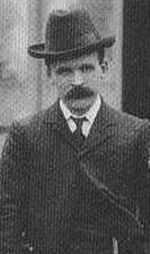Nantlais Williams

William Nantlais Williams (30 December 1874 – 18 June 1959), better known simply as Nantlais, was a Welsh poet and a Presbyterian Christian leader during the 1904-1905 Welsh Revival.
Background
Williams was born in Pencader, Carmarthenshire, the youngest of ten children. He received his elementary education at Ysgol y Bwrdd, New Inn, but because of the death of his brother he had to leave when he was twelve to take up an apprenticeship as a weaver.
At the age of twenty he started to preach and in 1895 he went to the prestigious Grammar School in Newcastle Emlyn. From there he went on to Trefeca College to train as a minister, but before he finished his studies he received a call to be minister of Bethany, Ammanford in 1900 and was ordained by the denomination (Presbyterian Church of Wales) in 1901. By 1902 he was married to Alice Maud Jones, a relative to J. T. Job, another leader of the 1904-1905 Welsh Revival. They had three children, including Rheinallt Nantlais Williams. His first wife died in 1911 and he married his second wife, Annie Price, a teacher, in 1916. Bethany, Ammanford was to be his only post as he stayed there until his retirement in 1944. He is buried in front of Bethany, Ammanford, next to J. T. Job and Gareth Davies.
Nantlais and the 1904-1905 Revival

Nantlais came heavily under the influence of the 1904-1905 Welsh Revival. In 1904 he was eager to be a popular poet-preacher, and at that he was already successful. He was a well sought after speaker at conferences all over Wales and his poetry won him various prizes including the Chair of the National Eisteddfod in 1902. Despite this success and popularity he became increasingly aware that there was something missing, he came to think that there was more to Christianity than being pompous and culturally active.
Before the 1904-1905 Welsh Revival, Nantlais himself was not a Christian. He came to faith on the weekend of 4–6 November 1904, the weekend that the Revival broke out in Ammanford. From that weekend onwards Nantlais dedicated the rest of his life’s work to Christ; practically that meant turning his back on the pompous preaching conferences and concentrating on his ministry at Bethany, Ammanford. He also put an end to his competitive work for the Eisteddfod.
Nantlais the Writer
Although he had given up the Eisteddfod by the end of 1904 he did not stop writing altogether. From 1904 onwards he largely concentrated on producing Christian literature. He was co-editor of Yr Efengylydd (The Evangelist) between 1916–1933 and Y Lladmerydd (The Interpreter) between 1922-1926. He was editor of Trysorfa’r Plant (Children’s Treasury) between 1934-1947. He was an important hymn writer; 13 of his hymns were included in his denomination’s Llyfyr Emynau (Common Hymn Book) in 1927, and 17 were included in Caneuon Ffydd (Faith Songs) released as recently as 2001. He was awarded for his work by the University of Wales when he received an honorary MA in 1958.
Standing against liberal theology
Nantlais was living in an age that saw Wales, as a whole, turn against its traditional Calvinistic theology. Secularism was getting a stronger grip on the people of Wales and Nantlais’ denomination was loosening its grip on the Doctrinal Basis they had since the Welsh Methodist revival. Nantlais ferociously opposed a report to restructure the denomination after the First World War because it included the possibility of letting go, or at least the loosening of the theology given down to them from the Methodist fathers. Nantlais published a series of articles in Goleuad (the denomination’s newsletter), later put together as a book, in which he criticized the moves of 1925 and attacked modernists within the Church that challenge the authority of scripture.
Conclusion
1904 was a turning point for Nantlais; he came to assurance of salvation in Christ. From there onwards his life changed and certainly his ministry changed. If there would be one criticism of him it would be his leniency towards the teaching of the Pietistic movement but the Welsh Methodist tradition held him from going to the extremes of some associated with the Keswick movement. He was an important hymn writer and will be seen in the line of descent of the Protestant Calvinistic Welsh tradition.
See also
Sources
- Gibbard, Noel: Nefol Dân – Agweddau ar ddiwygiad 1904-1905 : 2004